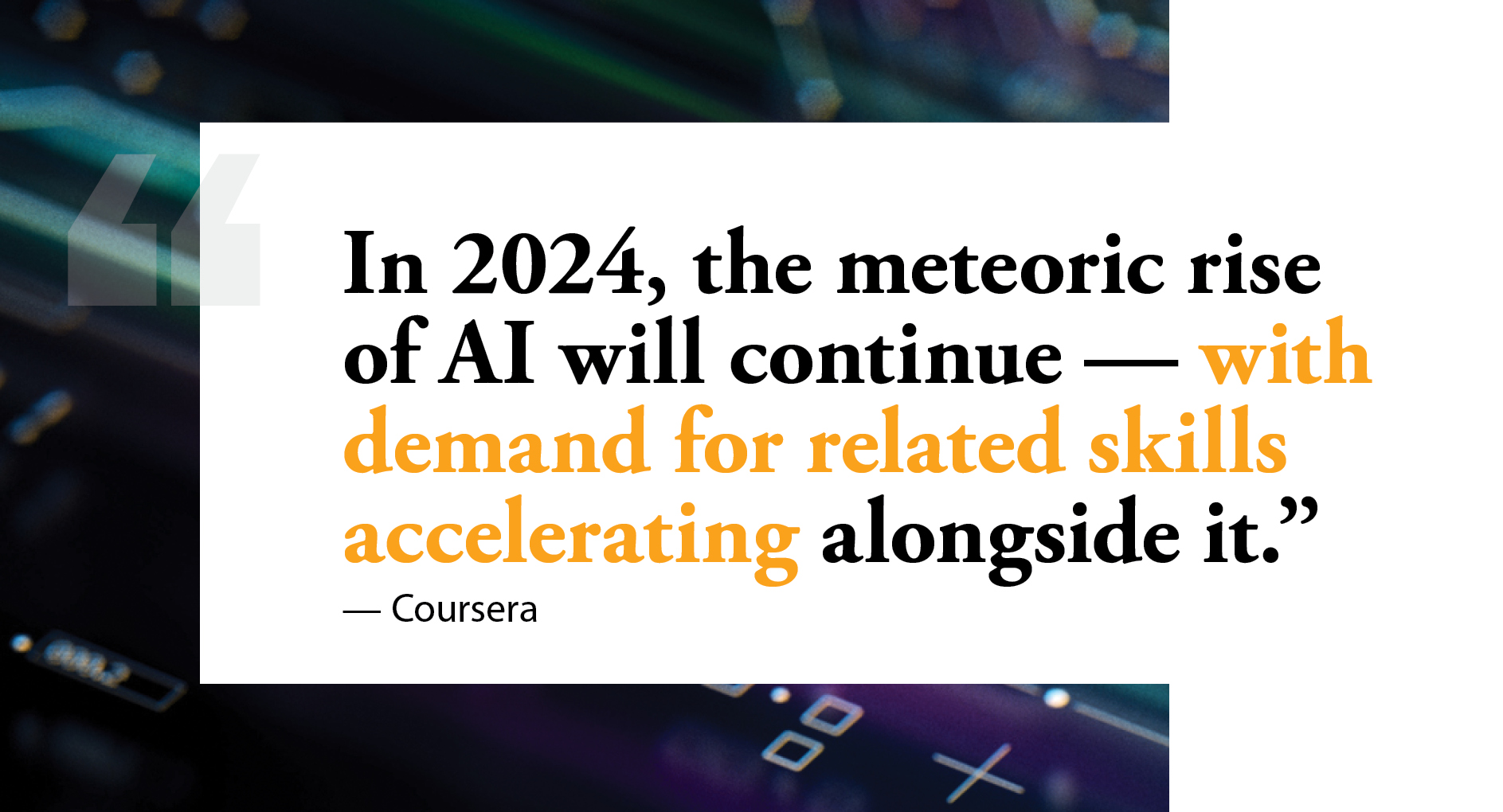When the topic turns to the potential impact of artificial intelligence, workforce development analysts consistently liken AI’s rapid and evolving emergence to such era-defining phenomena as the industrial and digital revolutions. AI, experts believe, will reshape the global workplace and redefine how companies compete.
“Make no mistake,” reads a report released in September by Boston Consulting Group, AI “is not a fleeting trend and will demand a reimaging of possibilities and a recalibration of strategies. As leaders come to grips with this technology, they have the opportunity to shape a legacy that will resonate far into the future.”
How that might play out remains the subject of widespread conjecture. And yet another key point of consensus is that the speed and depth of AI transformation will largely be determined by workers and how they adapt to the new, mysterious and rapidly evolving technology. Here are answers to five frequently asked questions being posed by business leaders as they seek to position their workforces for the AI future.
Which jobs is artificial intelligence most likely to impact?
What sets AI apart from previous transformative technologies is the spread of occupations it is likely to touch.
“What’s very interesting about AI is that it has the potential of having an impact on white-collar jobs and high-skilled jobs, which typically have been insulated from past technological revolutions,” said Raffaella Sadun of Harvard Business School, author of the report “Reskilling in the Age of AI,” in a recent interview with Harvard Business Review.
Her analysis squares with reporting from the Pew Research Center.
“Jobs with a high level of exposure to AI,” Pew’s Rakesh Kochhar reported in July, “tend to be in higher-paying fields where a college education and analytical skills can be a plus. Workers with a bachelor’s degree or more (27%) are more than twice as likely as those with a high school diploma only (12%) to see the most exposure. AI-driven business applications,” Kochhar writes, “represent a new reality for workers.”
The view that AI’s impact will reach across the the global workforce is endorsed, as well, by Goldman Sachs, which weighed in with a report released last March.
“We find,” said the authors, “that roughly two-thirds of current jobs are exposed to some degree of AI automation, and that generative AI could substitute up to one-fourth of current work. Extrapolating out estimates globally suggests that generative AI could expose the equivalent of 300 million full-time jobs to automation.”
How do the challenges posed by AI integration stack up against the opportunities?
The transformation, believes Harvard Business School’s Sadun, won’t be painless.
“From what we know from past technological revolutions,” she said in her interview, “it can take a while and it’s going to be a bumpy ride before we can really think about the revolutionary impact often mentioned in the press.”
But the potential benefits, on a macro scale, are immense.
“By some estimates,” reports Boston Consulting Group, “GenAI could amplify global GDP by 7% and double productivity over the next decade.”
That’s why some of the world’s most forward-leaning businesses are investing heavily in AI, with a major emphasis on worker training.
“Generative AI,” Forbes reported in August, “remains among the top priorities for CEOs. This was echoed in our June survey of over 2,300 C-suite leaders, [where] nearly all (97%) believe generative AI will be transformative and a game-changer for their company and industry. Right now, 44% are making big investments.”
Amazon is among those leading the way, having committed $700 million to training 100,000 employees into higher skilled work through its “Upskilling 2025” initiative. The online retailer says the investment will “help pilot, launch, and scale training programs to upskill employees in our corporate offices, tech hubs, fulfillment centers, retail stores, and transportation network, providing access to skills that will help them move into more highly skilled roles within or outside of Amazon.”
Where will I go to find AI-skilled workers?
As the Amazon example suggests, the solution is likely to come from in-house. A recent blog post by Australian futurist Ross Dawson quotes Gabe Dalporto, CEO of Udacity, the skills training provider.
“First of all,” said Dalporto, “our universities can’t turn out all the workers we’ll need for the jobs of the future, and it’s expensive. The cost of reskilling is so much less.”
Reskilling, asserts the Harvard Business School study, is “a strategic imperative.” Co-author Jorge Tamayo, assistant professor in the school’s Strategy Unit, believes the stakes involved and the size of the challenge necessitate engaged leadership from the C-suite.
“Usually, programs that are championed by the CEO are the ones that really work inside the company,” Tamayo told Site Selection magazine. Reskilling for AI, he said, “cannot be just an HR initiative because it’s so complex. It’s a change management initiative, not a training program. This is precisely the job of the CEO, to understand how the environment is changing, how the technology is changing, and how to connect corporate strategy with talent. You need to understand the big picture.”
Beside Amazon, which companies are investing in reskilling?
Dawson mentions AT&T, which launched a $1 billion, multi-year reskilling program in 2018. Known as Future Ready, the initiative, says Dawson, “is one of the private sector’s boldest investments in reskilling.”
He also refers to Microsoft, whose partnership with training provider General Assembly aims to reskill some 15,000 workers.

Harvard Business School cites Infosys, the India-based technology company, which it says has re-skilled 2,000 cybersecurity experts with adjacent competencies and capabilities. Vodaphone, the Harvard study reports, hopes to draw from internal talent to fill 40% of its software development needs.
“Mahindra & Mahindra, Wipro and Ericsson have policies, tools and IT platforms that promote reskilling resources and available jobs — as does McDonald’s, where restaurant employees have access to an app called Archways to Opportunity that maps skills learned on the job to career paths within the company and in other industries,” the study found.
“Finally,” says the report, “some companies are using reskilling to tap into broader talent pools and attract candidates who wouldn’t otherwise be considered for open positions. ICICI Bank — headquartered in Mumbai and employing more than 130,000 people — runs an intense, academy-like reskilling program that prepares graduates, often from diverse backgrounds, for frontline managerial jobs.”
With whom can I partner to reskill my workforce?
The options are many. In addition to Udacity and General Assembly, Silicon Valley-based Coursera is a widely recognized industry leader in delivering online skills training, boasting as it does 136 million learners and partnerships with 7,000 institutions in 100 countries. Coursera’s content, created in partnership with leading companies and universities, offers training geared toward AI, cybersecurity and leadership skills.
“The skills landscape is shifting,” Coursera said in a recently released report. “In 2024, the meteoric rise of AI will continue — with demand for related skills accelerating alongside it.”
The Harvard Business School study encourages corporate leaders to work with local colleges, nonprofits and industry partners to develop AI-savvy talent.
“Companies have tended to think of reskilling as an organization-level challenge, believing that they have to do the job by and for themselves. Instead of thinking of themselves as competitors for a limited talent pool, companies can team up to conduct joint training efforts, which may significantly attenuate some of the challenges. Coalitions of companies,” the report suggests, “may be more effective at the reskilling challenge than single organizations are.”

